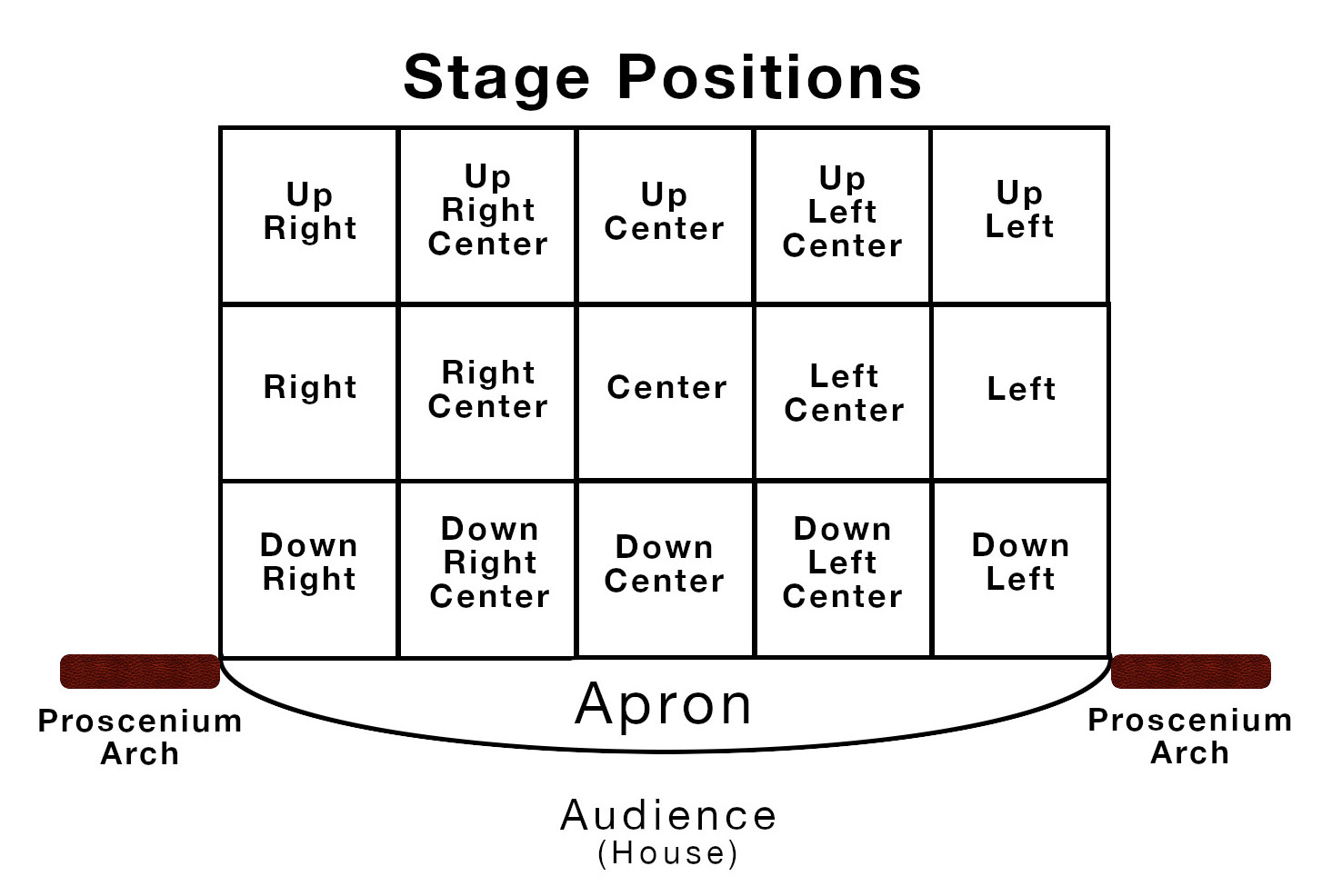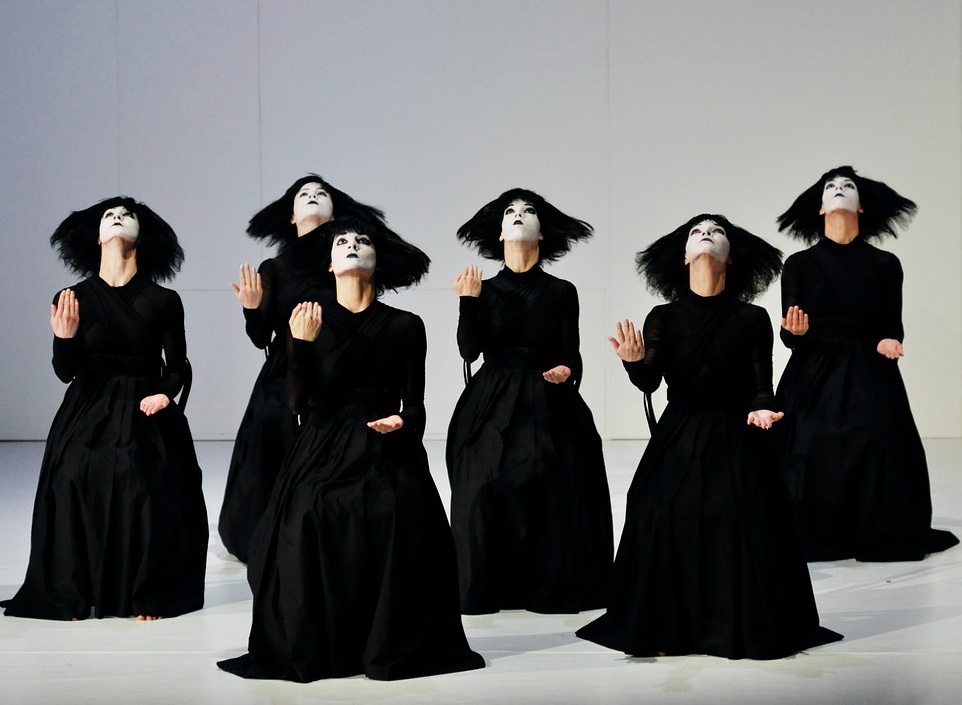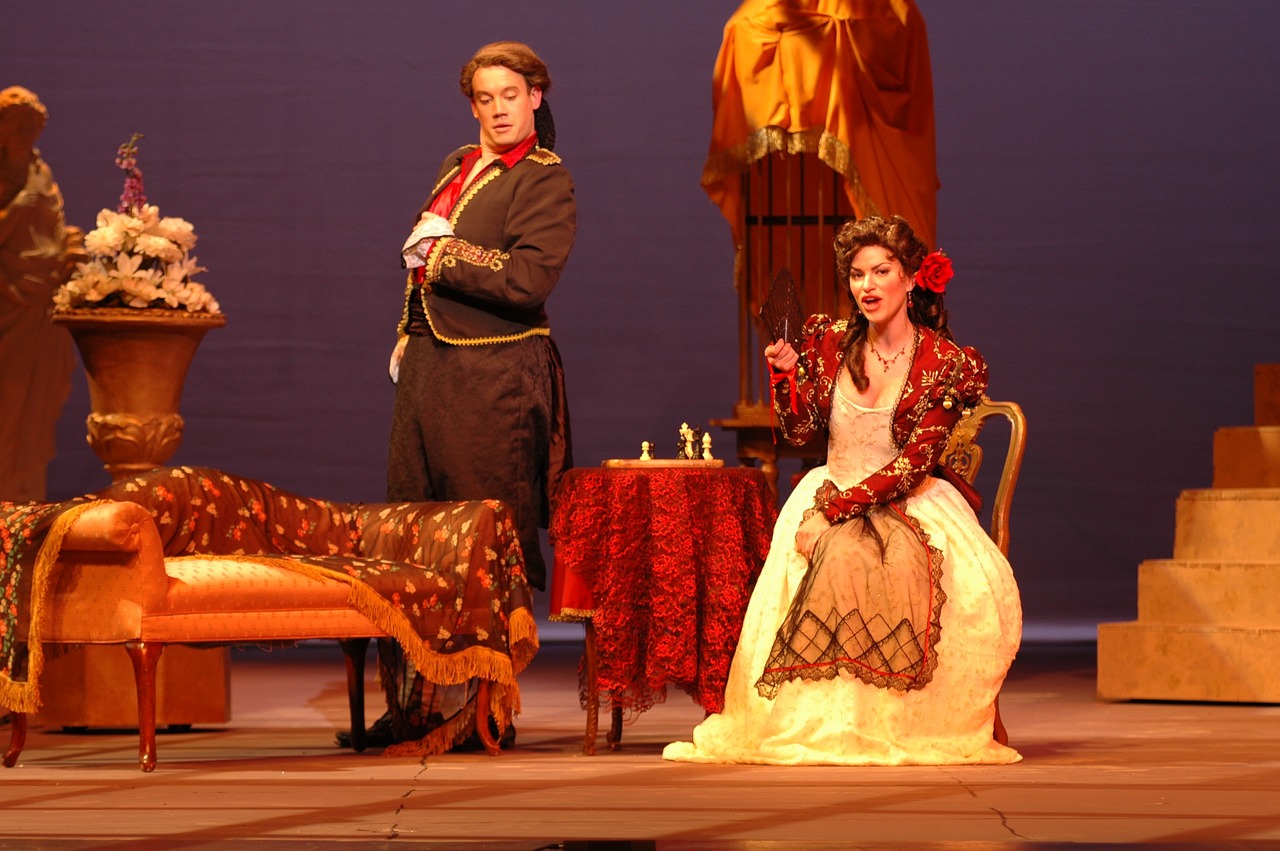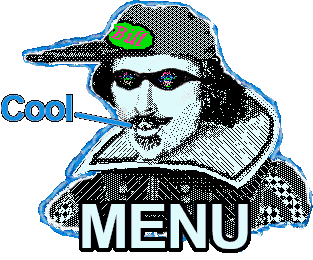ACTING POSITIONS ON A PROSCENIUM STAGE
Download and print a copy of this important graphic.

Most of the time, you will be acting on a proscenium stage. That is a stage which has a large arch (proscenium arch) that frames the frontmost portion of the acting area.
Almost all the acting takes place on the stage behind the area framed by the arch. The shallow stage area in front of the arch is called the apron. The apron can also be used as an acting area.
The areas of the stage are from the actors perspective
- Stage Right is the actor's right as the actor stands on the stage facing the audience.
- Stage left is the actor's left as the actor stands on the stage facing the audience.
- Upstage is the direction moving away from the audience.
- Downstage is moving closer towards the audience.
Centuries ago the audience area was on a flat floor. The stage was higher toward the back of the stage than toward the front so the audience could better see the action on the stage. Such an angled stage is called a "raked" stage. In those days as an actor moved away from the audience they would literally walk up the stage and when they moved towards the audience they would literally walk down the stage.
If the actor is facing upstage (toward the back wall), stage right and stage left are determined as if the actor were standing on the stage facing the audience.
The stage positions are used by the director to guide the actors' movements onstage. If your character has to move away from the audience and into a corner, the director might say to the actor, “Walk UL.”
When and where the actors are supposed to stand, sit, walk, enter, exit, dance, or otherwise move on, off, and about the stage during a performance is called the BLOCKING. You will hear that term a lot, so remember it.
Now practice all the different stage position until you can go to each one without thinking too hard. Make believe the room you are in is a theatre. Pick a wall to be the audience (the "house"). Cross (on stage, to move from one place to another is called a "cross") to the various stage positions. This works better if you have a buddy to help you, but if there isn't any one else there, do it anyway.
Learn this. Get comfortable with this. This is what actors need to know.
YOU ARE AN ACTRESS (OR ACTOR)
It is important to develop your identity as an actress/actor. We identify ourselves as many things. Students, workers, friends, lovers, sisters, brothers, uncles...many things. If you're like most people, "Actress" or "Actor" is not one of those things that you are regularly identified as. And you probably don't get a lot of reinforcement for your desire to be an actress. (Does this sound familiar? "An actress? You want to be an actress? Be sensible. Be an accountant maybe, or a doctor, or something where you can earn a living! An actress? Be sensible!")
When you get up in the morning, look at yourself in the mirror. Look into your own eyes and say to yourself - "I Am An Actress (or Actor)".
Say it like you mean it. Say it often. Even if you don't want to be a professional actress. Say it. It is important to identify yourself as an actress/actor.
Believe it.

Full Front
When the actor is facing the audience this position is called full front. This position is used for directly addressing the audience or to create a visual image that will help the audience understand a specific part of the story. Full Front is presentational in nature and engages the audience on the characters journey, but because the theater utilizes the ‘fourth wall’, when a character faces the audience it suggests to the audience that no other character on the stage is privy to the information being offered. This is the strongest of the positions for drawing focus because it demands the audience’s full attention.

¼ Turn (¼ left or ¼ right)
This strong position is the most commonly used because it offers the appearance of interaction while also allowing the audience to see ¾ of the actor. The actor is 'open' to the audience which is able to see how the character responds to the action and circumstances on stage.
To achieve the ¼ turn position, just move one of your legs more upstage (toward the back wall) then the other. This forces your body to turn a bit. Which way you turn depends upon which leg you move upstage. Stand up and try it.
When two performers "share" a scene on stage (they are both open to an equal degree), this is generally the position they will take. The ¼ turn position gives the appearance of social interaction or engagement with the action happening on stage. If they faced full front and talked to each other while looking straight out to the audience, well that would not look "natural". Although sometimes, an unnatural look might be the desired effect. Nothing in acting is set in stone. If they turned and faced each other directly (profile position) they would look "natural" but they would not be seen or heard very well by the audience. When two actors "share" a scene, they will usually assume the 1/4 position.
Although this position does not look totally natural, it is a theatre convention readily accepted by the audience. The trick is to be open enough to still be seen and heard well, but to be turned enough toward the other performer to appear to be looking at each other.

¾ Turn (¾ left or ¾ right)
When an actor’s feet are turned ¾ away from the audience, the audience is only able to see ¼ of the actor’s face and ¾ of his or her back. This can be used to indicate secrecy, establish a location, or used to convey information. If for example you have two actors crossing from Downstage Right to Upstage Left and one of the characters reaches out to place his/her arm around the other actor and then abandons the impulse before making physical contact, the audience will understand that character has romantic feelings for the other character, yet is afraid to pursue them. By using the ¾ turn position the audience is able to see information not known by the other character on stage because the action happened behind his or her back. This is the fourth strongest position for drawing focus since the audience receives very little in terms of character experience, but can be very beneficial in terms of delivering information.

Full Back
Full back is when the actor is facing upstage and all the audience can see is the actor’s back. Although this is the weakest position in terms of revealing character information, full back can be an effective staging position. It is often used as a way for characters to exit a scene without having them leave the stage or to provide specific information to the audience that other characters on stage are not supposed to know.

Profile
When an actor is facing the wings (left or right side of the stage) and only one side or profile of the actors body can be seen from the audience, the actor is in the profile position. This position is used in crosses and while delivering secret information. Although conversations in real life happen in profile, iIf you stage a dialogue in profile it will appear flat and the audience will wish to see more of the characters responses to the conversation. Remember to think of body positions as a storytelling tool. This is the third strongest position because the audience is receiving half of the characters experience and information.
Generally, actors are not aimlessly meandering about the acting area. Each actor in the acting area should be in their specific space and in physical relation to the other actors for a specific reason - and those reasons will change often during the course of a scene.
Sometimes, an actor might move from one stage position to another stage position, making adjustments in relation to the movements and positions of other characters. Often times this is simply to maintain a pleasing stage picture; a 'visual balance'. For instance one character might cross from stage center left to down center stage so the audience can focus on a brief monolog the character will give. At the same time, another character might cross from down center right to up center right, reducing audience focus on their character, so the audience's attention can be more intensely focused on the character moving down center stage to deliver the monolog. These 'countercross' movements occur quite frequently during a scene.
As much as possible actors should move across the stage in arcs rather than straight lines. The arc pattern gives the appearance of ease and casualness to the movement. Whereas a cross that is in a straight line conveys urgency. As a character’s situation becomes more dire, and their needs more urgent, their cossess will become straight lines rather than arcs. This allows the actor to convey information to the audience that is not expressed in the dialog.
Where an actor stands or moves on the stage conveys to the audience information about the character, relationships among characters, and helps tell the story. The more the actor can be seen and heard by the audience, the more information the audience can receive.
An actor's movement must portray the character; their personality, attitude, health, age, etc. The movement can reveal it all. To give a convincing portrayal of the character, a actor must always move in character.
The proximity of one character to another can reveal information about the current relationship between the characters. Characters who are quite far apart could be interpreted as being strangers, or that something is keeping them apart, or that they are in different locations. Intimacy is built among characters as the distance between them diminishes. This intimacy could be contentious, friendly, secretive, or romantic depending upon past or current actions.
RESOURCES
Of course a website cannot tell you all the information you need to know about preparing yourself to be an actor: unions, contracts, agents, casting, auditions, and the myriads of other things actors should learn about the acting business.
Below are a number of resources that will help you learn about such things to get you on the right road to becoming a successful actor.


Copyright © All rights reserved.
Website designed by Dave-Blank-Website-Design.com








